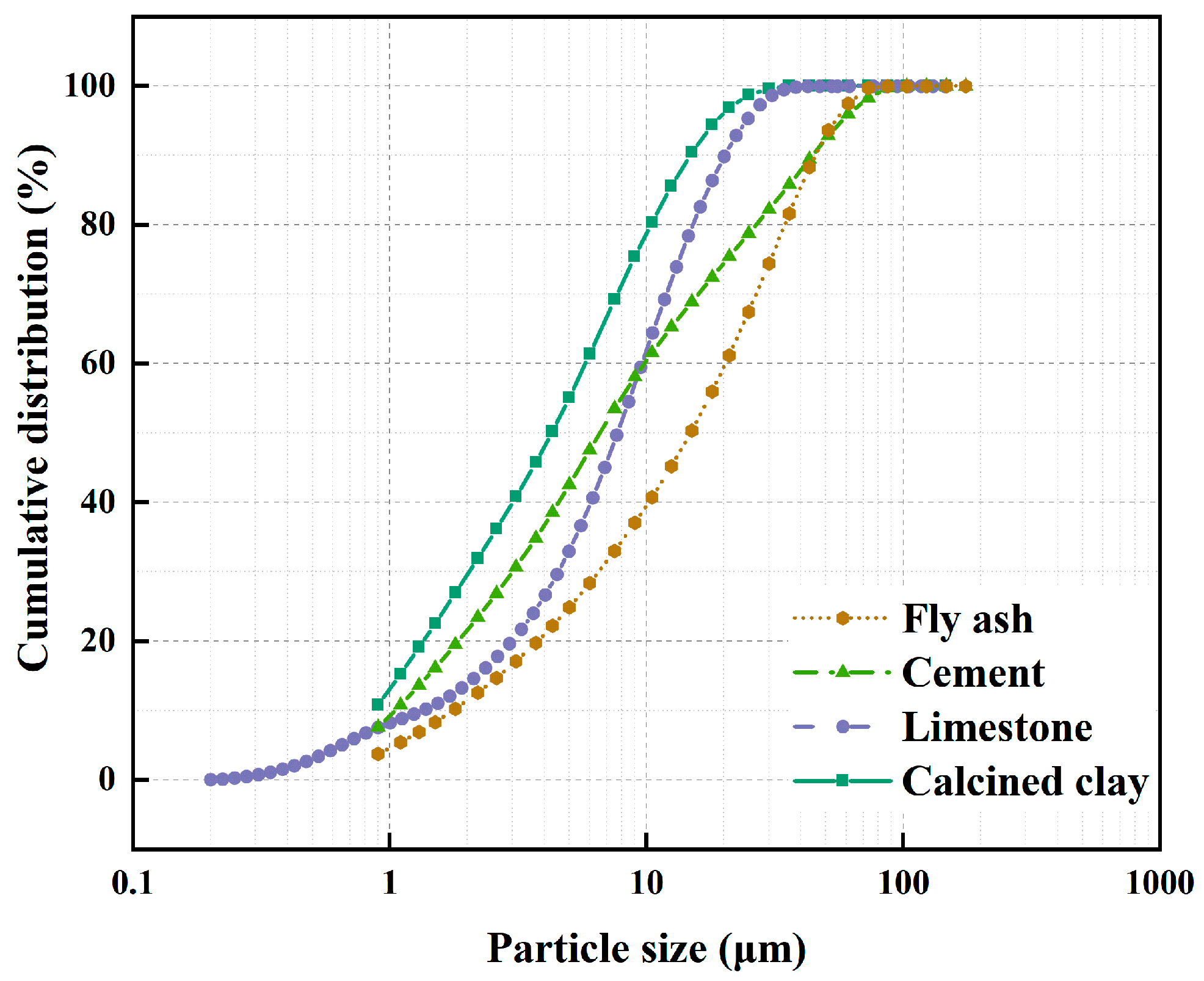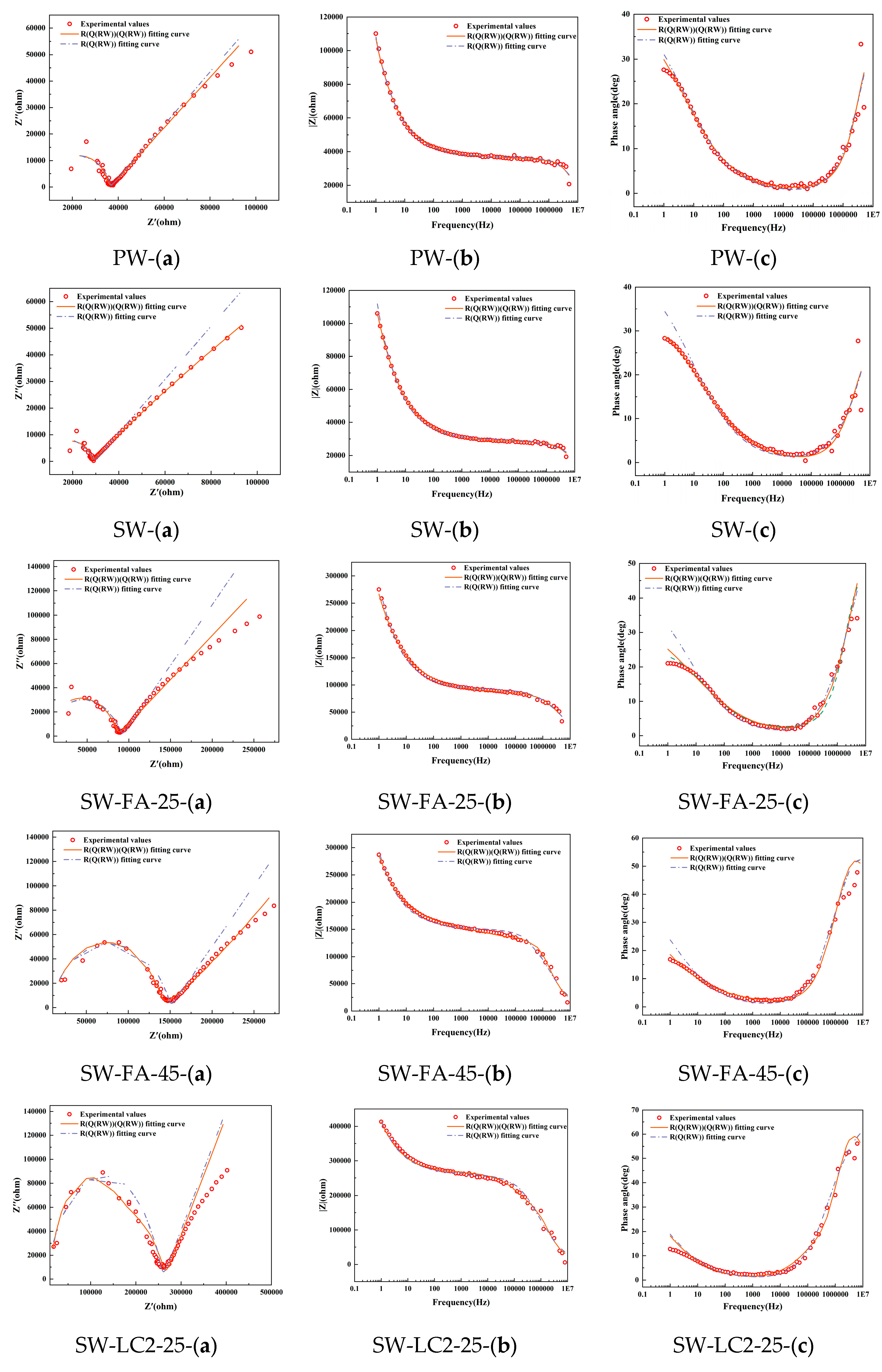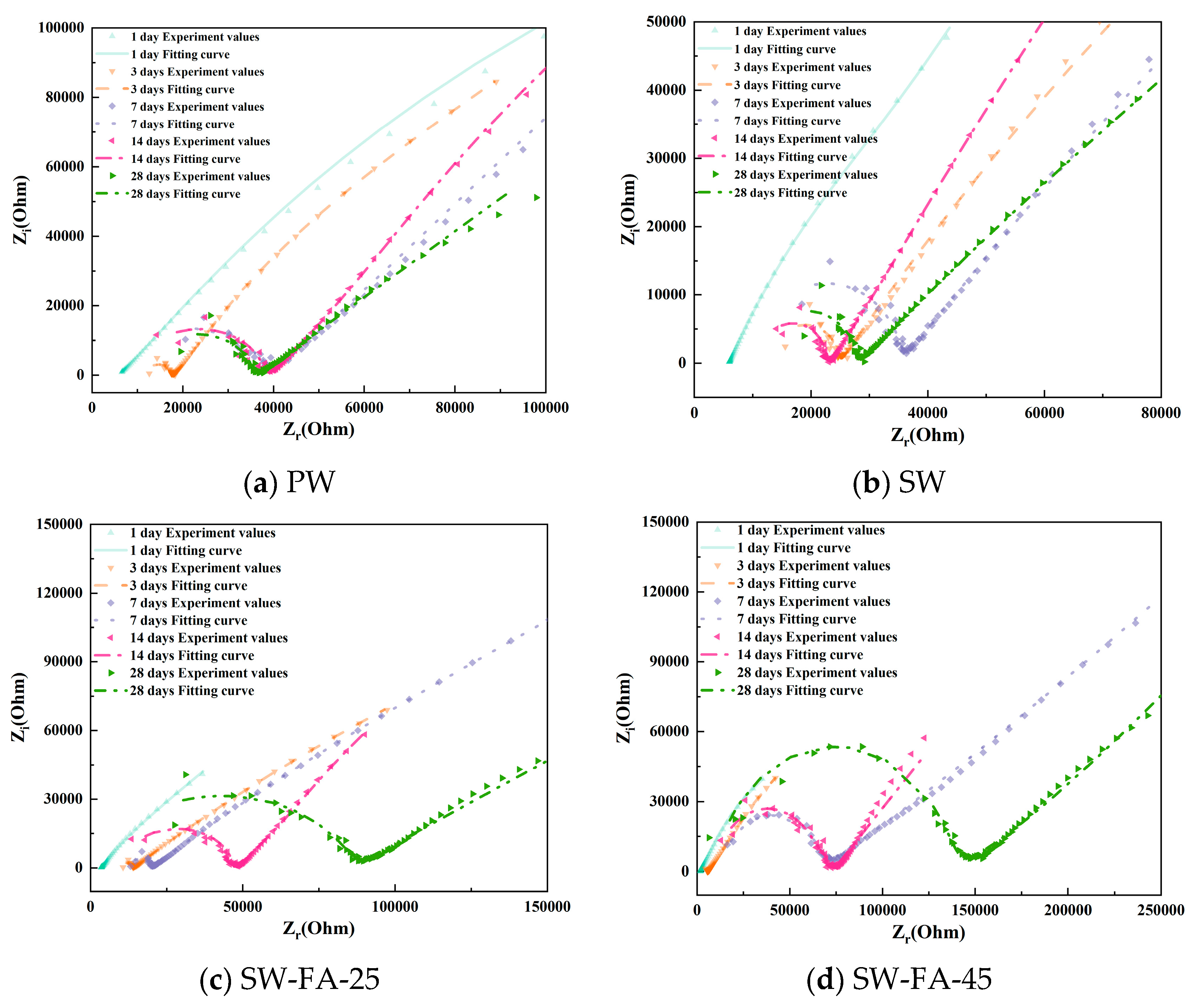Non-Destructive Monitoring of Hydration Characteristics in Alternative Materials and Seawater-Based Cementitious Pastes Using Electrochemical Impedance Spectroscopy
Abstract
:1. Introduction
2. Experiments and Methods
EIS Testing
3. Result and Analysis
4. Conclusions
- Guided by the distinctive electrochemical attributes of the fly ash, LC2, and seawater cement materials hydration process, a groundbreaking EC Model 2 was devised for monitoring the progression of cement hydration.
- Analysis of the novel EC model reveals that the combination of LC2, fly ash, and seawater creates a synergistic effect that significantly accelerates the hydration process. Notably, increasing the content of LC2 and fly ash enhances this acceleration, suggesting that precise adjustments in their proportions can be strategically used to tailor the hydration kinetics for specific performance requirements in cementitious materials.
- When seawater is used to replace freshwater in cement mixtures, the incorporation of LC2 (limestone and calcined clay) has been shown to more effectively accelerate the hydration process and enhance the pore structure of the cement more effectively than the use of fly ash. This superior performance of LC2 can be attributed to its unique chemical and mineralogical composition, which reacts more rapidly with the available ions in seawater, resulting in the development of more compact hydration products. These products fill the capillary pores more effectively, reducing porosity and resulting in a more refined microstructure. In contrast, while fly ash also contributes to hydration, its slower reactivity and less pronounced effect on pore structure make LC2 a more advantageous additive when optimizing for early strength and durability, particularly in environments where seawater is utilized.
Author Contributions
Funding
Informed Consent Statement
Data Availability Statement
Conflicts of Interest
References
- Bahhou, A.; Taha, Y.; Hakkou, R.; Benzaazoua, M.; Tagnit-Hamou, A. Assessment of hydration, strength, and microstructure of three different grades of calcined marls derived from phosphate by-products. J. Build. Eng. 2024, 84, 108640. [Google Scholar] [CrossRef]
- Liu, S.; Wang, Y.; Wu, A.; Shi, D.; Yang, S.; Ruan, Z.; Song, X.; Zhang, M. Early mechanical strength, hydration mechanism and leaching behavior of alkali-activated slag/fly ash paste filling materials. J. Build. Eng. 2024, 84, 108481. [Google Scholar] [CrossRef]
- Ming, X.; Si, W.; Yu, Q.; Sun, Z.; Qiu, G.; Cao, M.; Li, Y.; Li, Z. Molecular insight into the initial hydration of tricalcium aluminate. Nat. Commun. 2024, 15, 2929. [Google Scholar] [CrossRef]
- Yang, J.; Chen, C.; Chen, S.; Ren, Y.; Lu, J. Resource utilization of drinking water treatment aluminum sludge in green cementing materials: Hydration characteristics and hydration kinetics. J. Environ. Sci. 2024, 144, 236–248. [Google Scholar] [CrossRef]
- Zhang, C.; Song, W.; Taheri, A.; Fu, J.; Zhao, T.; Tan, Y. Hydration mechanism and mechanical-thermal correlation of cemented paste backfill under different curing temperatures. J. Build. Eng. 2024, 85, 108691. [Google Scholar] [CrossRef]
- Zheng, H.; Duan, Y.; Li, M.; Hou, D.; Wang, P.; Chen, J.; Li, S. Reaction molecular dynamics study of calcium alumino-silicate hydrate gel in the hydration deposition process at the calcium silicate hydrate interface: The influence of Al/Si. J. Build. Eng. 2024, 86, 108823. [Google Scholar] [CrossRef]
- Leng, D.; Fu, Q.; Ge, Y.; He, C.; Lv, Y.; Li, X. Effect of K+ Diffusion on Hydration of Magnesium Potassium Phosphate Cement with Different Mg/P Ratios: Experiments and Molecular Dynamics Simulation Calculations. Materials 2024, 17, 1151. [Google Scholar] [CrossRef] [PubMed]
- Jiang, K.; Yu, H.; Sun, Z.; Lei, Z.; Li, K.; Wang, L. Zero-Emission Cement Plants with Advanced Amine-Based CO2 Capture. Environ. Sci. Technol. 2024, 58, 6978–6987. [Google Scholar] [CrossRef]
- Liao, G.; Wang, D.; Wang, W.; He, Y. Microstructure, strength development mechanism, and CO2 emission analyses of alkali-activated fly ash-slag mortars. J. Clean. Prod. 2024, 442, 141116. [Google Scholar] [CrossRef]
- Pehl, M.; Schreyer, F.; Luderer, G. Modelling long-term industry energy demand and CO2 emissions in the system context using REMIND (version 3.1.0). Geosci. Model Dev. 2024, 17, 2015–2038. [Google Scholar] [CrossRef]
- Lazorenko, G.; Kravchenko, E.; Kasprzhitskii, A.; Fini, E.H. An evaluation of the environmental impact and energy efficiency of producing geopolymer mortar with plastic aggregates. Resour. Conserv. Recycl. Adv. 2024, 22, 200216. [Google Scholar] [CrossRef]
- Kravchenko, E.; Lu, W.; Sauerwein, M.; Wong, A.H.K. Life cycle assessment of waste materials in deep cement mixing for land reclamation in Hong Kong. Environ. Impact Assess. Rev. 2024, 105, 107398. [Google Scholar] [CrossRef]
- Gao, Y.; Zhu, Z.; Zhu, J.; Hu, X. Study on the mechanical properties and water stability of steel slag-fly ash geopolymer for base Stabilisation. Int. J. Pavement Eng. 2024, 25, 2308168. [Google Scholar] [CrossRef]
- Kampala, A.; Suebsuk, J.; Sakdinakorn, R.; Arngbunta, A.; Chindaprasirt, P. Coal-biomass fly ash as cement replacement in loess stabilisation for road materials. Int. J. Pavement Eng. 2024, 25, 2296956. [Google Scholar] [CrossRef]
- Xu, W.; Niu, X.; Zhu, Y. Deformation behavior and damage evaluation of fly ash-slag based geopolymer concrete under cyclic tension. J. Build. Eng. 2024, 86, 108664. [Google Scholar] [CrossRef]
- Liu, J.; Xing, F.; Dong, B.; Ma, H.; Pan, D. Study on Surface Permeability of Concrete under Immersion. Materials 2014, 7, 876–886. [Google Scholar] [CrossRef] [PubMed]
- Zhang, Y.; Zhu, X.; Shah, S.P. Reinforcing efficiency of nanomaterials on mechanical and interfacial characteristics of green concrete incorporating fly ash cenosphere. J. Clean. Prod. 2024, 447, 141531. [Google Scholar] [CrossRef]
- Zhang, W.; Zheng, C.; Li, Z.; Jin, H.; Liu, J.; Zhu, J.; Liu, W.; Xing, F. Investigation on mechanical properties improvement of seawater engineered cementitious composites (ECC) using FA/LC2. Constr. Build. Mater. 2022, 345, 128271. [Google Scholar] [CrossRef]
- Govindarajan, D.; Gopalakrishnan, R. Magnetic susceptibility measurements on metakaolin admixtured cement hydrated with ground water and sea water. Int. J. Miner. Metall. Mater. 2009, 16, 349–354. [Google Scholar] [CrossRef]
- Xiong, L.; Liu, C. Dynamic mechanical properties of cement mortar after corroded by sea water. Chin. J. Rock Mech. Eng. 2013, 32, 2481–2488. [Google Scholar]
- Etxeberria, M.; Gonzalez-Corominas, A. Properties of Plain Concrete Produced Employing Recycled Aggregates and Sea Water. Int. J. Civ. Eng. 2018, 16, 993–1003. [Google Scholar] [CrossRef]
- Sosa Gallardo, A.F.; Provis, J.L. Electrochemical cell design and impedance spectroscopy of cement hydration. J. Mater. Sci. 2021, 56, 1203–1220. [Google Scholar] [CrossRef]
- Fang, Q.; Li, S. Electrochemical Impedance Spectroscopy Study on Hydration Feature of Calcium Sulfoaluminate Cements. Int. J. Electrochem. Sci. 2019, 14, 5042–5050. [Google Scholar] [CrossRef]
- Li, C.; Fan, Y.; Li, Q. Performance of Cement Paste with Metakaolin Based on Electrochemical Impedance Spectroscopy. J. Build. Mater. 2020, 23, 755–762. [Google Scholar]
- Song, G.L. Equivalent circuit model for AC electrochemical impedance spectroscopy of concrete. Cem. Concr. Res. 2000, 30, 1723–1730. [Google Scholar] [CrossRef]
- Dong, B.; Qiu, Q.; Gu, Z.; Xiang, J.; Huang, C.; Fang, Y.; Xing, F.; Liu, W. Characterization of carbonation behavior of fly ash blended cement materials by the electrochemical impedance spectroscopy method. Cem. Concr. Compos. 2016, 65, 118–127. [Google Scholar] [CrossRef]
- GB175-2007; Common Portland Cement. General Administration of Quality Supervision, Inspection and Quarantine of the People’s Republic of China. National Standardization Administration of China: Beijing, China; Standards Press of China: Beijing, China, 2007.
- GB1596-2017; Fly Ash Used for Cememt and Concrete. General Administration of Quality Supervision, Inspection and Quarantine of the People’s Republic of China. National Standardization Administration of China: Beijing, China, 2017.
- Randle, J.E.B. Kinetics of Rapid Electrode Reactions. Faraday Soc. 1947, 1, 11–19. [Google Scholar] [CrossRef]
- Ping, X.; Ping, G.; Xu, Z.Z.; Beaudoin, J.J. A rationalized ac impedance model for microstructural characterization of hydrating cement systems. Cem. Concr. Res. 1993, 23, 359–367. [Google Scholar]
- Double, D.D.; Hellawell, A.; Perry, S.J. Hydration of portland-cement. Proc. R. Soc. Lond. Ser. A-Math. Phys. Eng. Sci. 1978, 359, 435. [Google Scholar] [CrossRef]
- Wei, X.; Xiao, L.; Li, Z. Electrical Measurement to Assess Hydration Process and the Porosity Formation. J. Wuhan Univ. Technol.-Mater. Sci. Ed. 2008, 23, 761–766. [Google Scholar] [CrossRef]









| Materials | SiO2 | Al2O3 | CaO | Fe2O3 | MgO | K2O | SO3 | Loss |
|---|---|---|---|---|---|---|---|---|
| OPC | 20.3 | 5.6 | 61.8 | 3.5 | 2.1 | 1.6 | 4.2 | 4.2 |
| Calcined clay | 55.8 | 38 | 0.3 | 1.6 | 0.4 | 3.4 | 0.2 | - |
| Fly ash | 49.8 | 24.7 | 6.2 | 9.4 | 1.4 | 2.1 | 0.8 | 0.5 |
| Sample ID | Cement | Water | Seawater | Fly Ash | Calcined Clay | Limestone | Gypsum |
|---|---|---|---|---|---|---|---|
| PW | 1300 | 520 | - | - | - | - | - |
| SW | 1300 | - | 520 | - | - | - | - |
| SW-FA-25 | 975 | - | 520 | 325 | - | - | - |
| SW-FA-45 | 715 | - | 520 | 585 | - | - | - |
| SW-LC2-25 | 958 | - | 520 | - | 216.6 | 108.3 | 17.1 |
| SW-LC2-45 | 684 | - | 520 | - | 390 | 195 | 31 |
Disclaimer/Publisher’s Note: The statements, opinions and data contained in all publications are solely those of the individual author(s) and contributor(s) and not of MDPI and/or the editor(s). MDPI and/or the editor(s) disclaim responsibility for any injury to people or property resulting from any ideas, methods, instructions or products referred to in the content. |
© 2024 by the authors. Licensee MDPI, Basel, Switzerland. This article is an open access article distributed under the terms and conditions of the Creative Commons Attribution (CC BY) license (https://creativecommons.org/licenses/by/4.0/).
Share and Cite
Gao, F.; Cheng, L.; Liu, J.; Zhu, J. Non-Destructive Monitoring of Hydration Characteristics in Alternative Materials and Seawater-Based Cementitious Pastes Using Electrochemical Impedance Spectroscopy. Sustainability 2024, 16, 7368. https://doi.org/10.3390/su16177368
Gao F, Cheng L, Liu J, Zhu J. Non-Destructive Monitoring of Hydration Characteristics in Alternative Materials and Seawater-Based Cementitious Pastes Using Electrochemical Impedance Spectroscopy. Sustainability. 2024; 16(17):7368. https://doi.org/10.3390/su16177368
Chicago/Turabian StyleGao, Fangsheng, Lei Cheng, Jun Liu, and Jihua Zhu. 2024. "Non-Destructive Monitoring of Hydration Characteristics in Alternative Materials and Seawater-Based Cementitious Pastes Using Electrochemical Impedance Spectroscopy" Sustainability 16, no. 17: 7368. https://doi.org/10.3390/su16177368





